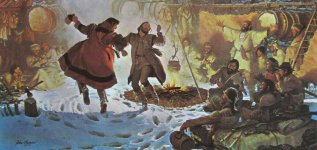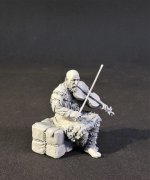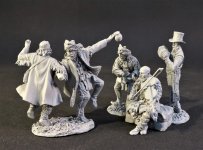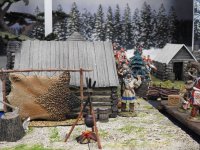- Joined
- Feb 2, 2011
- Messages
- 2,338
JJDESIGNS NEWS UPDATE 11[SUP]th[/SUP] JANUARY 2021
THE FUR TRADE
MOUNTAIN MEN – THE RENDEZVOUS
A mountain man was an explorer who lived in the wilderness. They were instrumental in opening up the various Emigrant Trails (widened into wagon roads) allowing Americans in the east to settle the new territories of the far west by organized wagon trains traveling over roads explored and in many cases, physically improved by the mountain men and the big fur companies originally to serve the mule train based inland fur trade.
Mountain men were most common in the North American Rocky Mountains from about 1810 through to the 1880s (with a peak population in the early 1840s). Approximately 3,000 mountain men ranged the mountains between 1820 and 1840, the peak beaver-harvesting period. While there were many free trappers, most mountain men were employed by major fur companies. The life of a company man was almost militarized. The men had mess groups, hunted and trapped in brigades and always reported to the head of the trapping party.
This man was called a "boosway", a bastardization of the French term bourgeois. He was the leader of the brigade and the head trader.
The Mountain men represents the “Beaver Pelts” of the original WSP title, and is the smallest part of the series, as it mainly concentrates on the individual men and personalities that worked alone or in pairs in the mountain wilderness.

THE ROCKY MOUNTAIN RENDEZVOUS
The Rendezvous was an annual gathering, at various locations held by a fur trading company at which trappers and mountain men sold their furs and hides and replenished their supplies.
The large fur companies put together teamster driven mule trains which packed in whiskey and supplies into a pre-announced location each spring/summer and set up a trading fair- the Rendezvous.

These Rendezvous were known to be lively, joyous places, where all were welcome, fur trappers, Indians, native trapper wives, and children, travelers and later on even tourists who would venture from as far as Europe to observe the festivities.
They were described as events “full of myrth, songs, dancing, shouting, trading, running, singing, racing, target-shooting, yarns, frolics, with all sorts of extravagances that white men or Indians could invent!”

This “Whisky” inspired section, should be a whole load of fun, as it will include trading and drinking scenes, set around the trading post, “Fort Whoop-Up”!,
The first of these previewed figures should be available this summer!
Fort Whoop-Up, (originally Fort Hamilton) was the official name given to a trading post, near what is now Lethbridge, Alberta. During the 19[SUP]th[/SUP] Century the post served as a centre for trading activities, including the illegal trade of whisky.

SOME NOTES FROM JOHN
This Mountain Men Rendezvous scene, was inspired by the John Clymer painting, “ALOUETTE” produced in 1974. The work of John Clymer is well known for its historical accuracy in capturing the world and experiences of frontiersmen, fur traders, gold seekers, and pioneers of the American west.
Best wishes
john jenkins
THE FUR TRADE
MOUNTAIN MEN – THE RENDEZVOUS
A mountain man was an explorer who lived in the wilderness. They were instrumental in opening up the various Emigrant Trails (widened into wagon roads) allowing Americans in the east to settle the new territories of the far west by organized wagon trains traveling over roads explored and in many cases, physically improved by the mountain men and the big fur companies originally to serve the mule train based inland fur trade.
Mountain men were most common in the North American Rocky Mountains from about 1810 through to the 1880s (with a peak population in the early 1840s). Approximately 3,000 mountain men ranged the mountains between 1820 and 1840, the peak beaver-harvesting period. While there were many free trappers, most mountain men were employed by major fur companies. The life of a company man was almost militarized. The men had mess groups, hunted and trapped in brigades and always reported to the head of the trapping party.
This man was called a "boosway", a bastardization of the French term bourgeois. He was the leader of the brigade and the head trader.
The Mountain men represents the “Beaver Pelts” of the original WSP title, and is the smallest part of the series, as it mainly concentrates on the individual men and personalities that worked alone or in pairs in the mountain wilderness.

THE ROCKY MOUNTAIN RENDEZVOUS
The Rendezvous was an annual gathering, at various locations held by a fur trading company at which trappers and mountain men sold their furs and hides and replenished their supplies.
The large fur companies put together teamster driven mule trains which packed in whiskey and supplies into a pre-announced location each spring/summer and set up a trading fair- the Rendezvous.

These Rendezvous were known to be lively, joyous places, where all were welcome, fur trappers, Indians, native trapper wives, and children, travelers and later on even tourists who would venture from as far as Europe to observe the festivities.
They were described as events “full of myrth, songs, dancing, shouting, trading, running, singing, racing, target-shooting, yarns, frolics, with all sorts of extravagances that white men or Indians could invent!”

This “Whisky” inspired section, should be a whole load of fun, as it will include trading and drinking scenes, set around the trading post, “Fort Whoop-Up”!,
The first of these previewed figures should be available this summer!
Fort Whoop-Up, (originally Fort Hamilton) was the official name given to a trading post, near what is now Lethbridge, Alberta. During the 19[SUP]th[/SUP] Century the post served as a centre for trading activities, including the illegal trade of whisky.

SOME NOTES FROM JOHN
This Mountain Men Rendezvous scene, was inspired by the John Clymer painting, “ALOUETTE” produced in 1974. The work of John Clymer is well known for its historical accuracy in capturing the world and experiences of frontiersmen, fur traders, gold seekers, and pioneers of the American west.
Best wishes
john jenkins






